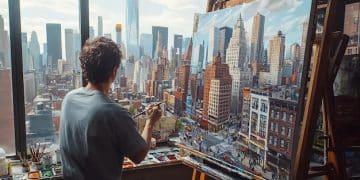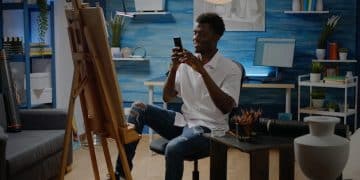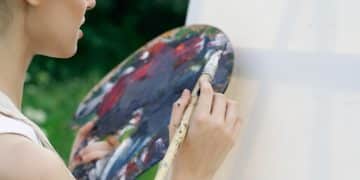How to Build a Thriving Art Career in the US: Expert Tips
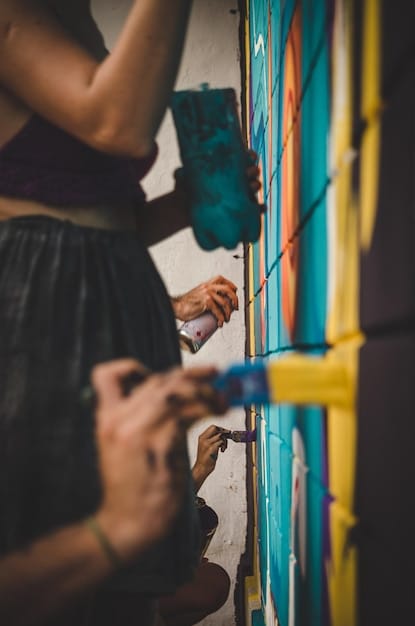
Building a successful art career in the US involves strategic planning, networking, continuous learning, and adapting to the evolving art market, focusing on authenticity and creating a strong personal brand.
Are you an aspiring artist dreaming of turning your passion into a sustainable career in the United States? Navigating the art world can be challenging, but with the right strategies, dedication, and insights, a fulfilling and profitable path is within reach. Let’s explore how to build a successful art career in the US with expert advice.
Understanding the US Art Market Landscape
Gaining a firm grasp on the US art market is the first step toward career success. This market is diverse, encompassing galleries, museums, private collectors, and online platforms. Each segment has its own nuances and preferences, so understanding them is essential.
Major Art Hubs in the US
The US art scene is not monolithic; certain cities stand out as major hubs for artists. New York City, Los Angeles, Chicago, and Miami are just a few examples, each with distinct characteristics. Understanding the local art community in these cities can be beneficial.
The Role of Art Galleries
Art galleries play a crucial role in an artist’s career, providing exposure and sales opportunities. Building relationships with gallery owners and curators is key to securing representation. Research galleries that align with your style and approach them professionally.
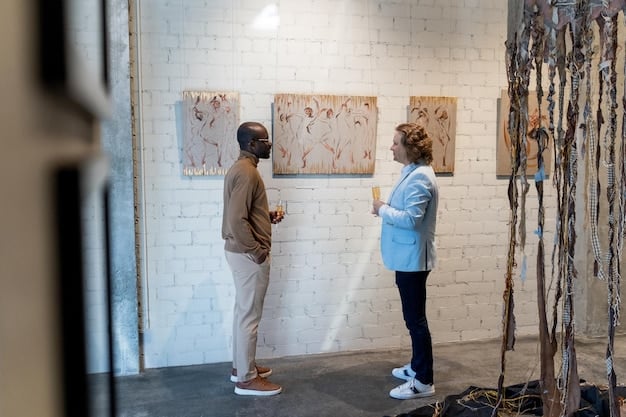
Here are essential aspects to consider when navigating the US art market:
- Research: Understand the different market segments (galleries, museums, private collectors, online platforms).
- Networking: Attend art fairs, gallery openings, and artist talks to build connections.
- Targeting: Identify the galleries and collectors that align with your artistic style and career goals.
- Adaptation: Be prepared to adapt your work or presentation to suit different market demands.
Understanding the dynamics of the US art market is essential for any artist aiming for a sustainable and successful career. By recognizing the key players, trends, and opportunities, artists can strategically position themselves and increase their chances of success.
Defining Your Artistic Identity and Brand
In a competitive market, having a strong artistic identity and brand is vital. This involves understanding your unique style, communicating it effectively, and building a recognizable presence in the art world. Authenticity is the cornerstone of a successful art career.
Crafting Your Artist Statement
An artist statement succinctly describes your work’s themes, techniques, and inspirations. It serves as an introduction to your art for potential buyers, curators, and gallery owners. Make it clear, concise, and compelling.
Building Your Online Presence
In the digital age, a strong online presence is non-negotiable. A professional website, active social media profiles, and online portfolios are essential tools for showcasing your work to a global audience. Regularly update your online platforms with fresh content.
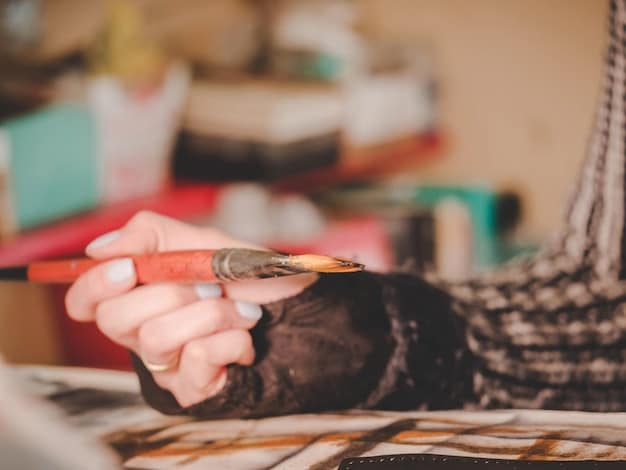
To define your artistic identity and brand, consider the following:
- Authenticity: Create art that reflects your true passions and unique perspectives.
- Consistency: Maintain a consistent style and brand across all your artworks and online platforms.
- Storytelling: Communicate the stories and inspirations behind your art in a compelling way.
- Engagement: Engage with your audience on social media and build a loyal following.
Defining your artistic identity and brand is not just about creating art; it’s about telling your story and connecting with others who appreciate your vision. A clear and consistent brand will help you stand out in a crowded market and attract the right opportunities.
Networking and Building Relationships
The art world thrives on relationships. Building a strong network of fellow artists, curators, gallery owners, and collectors can open doors to new opportunities and collaborations. Networking is an ongoing process that requires patience and genuine connection.
Attending Art Events and Openings
Art fairs, gallery openings, and artist talks are excellent opportunities to meet people in the art world. Come prepared to discuss your work and learn about others. Remember, networking is a two-way street; offer as much value as you seek.
Joining Art Associations and Communities
Art associations and communities provide support, resources, and networking opportunities for artists. Participating in these groups can help you connect with peers, receive feedback on your work, and gain access to exhibition opportunities.
Effective networking involves several key strategies:
- Be Prepared: Have a concise and compelling introduction to your work ready.
- Engage: Show genuine interest in others and their work.
- Follow-Up: Send thank-you notes or emails to people you connect with.
- Stay Active: Regularly attend art events and engage in online communities.
Networking is more than just exchanging business cards; it’s about building meaningful relationships that can support and enrich your art career. By actively engaging with the art community, artists can create a powerful network that opens doors to new opportunities and collaborations.
Developing a Strong Portfolio
Your portfolio is a crucial tool for showcasing your best work to potential buyers and gallery owners. It should be well-organized, visually appealing, and reflective of your artistic style. A strong portfolio demonstrates your skills and artistic vision.
Selecting Your Best Pieces
Curate your portfolio with your strongest and most representative works. Choose pieces that showcase your unique style, technical skills, and artistic vision. Quality over quantity is key; a few exceptional pieces are better than many mediocre ones.
Presenting Your Work Professionally
Present your work in a professional manner. Use high-quality images, clear descriptions, and a well-designed layout. Whether presenting your portfolio online or in person, make sure it is easy to navigate and visually engaging.
A compelling portfolio includes the following:
- High-Quality Images: Use professional photos of your artwork.
- Clear Descriptions: Provide detailed information about each piece, including title, medium, size, and date.
- Variety: Include a variety of pieces that showcase your range and skills.
- Organization: Arrange your portfolio logically, highlighting your best work.
A well-developed portfolio is essential for any artist looking to gain recognition and opportunities in the art world. By carefully selecting and presenting your best work, you can make a lasting impression and effectively communicate your artistic vision to potential buyers and gallery owners.
Pricing Your Artwork Effectively
Pricing your artwork is a critical aspect of building a successful art career. It requires balancing your artistic value with market demand. Understanding how to price your work effectively is crucial for making sales and establishing your reputation.
Researching Market Prices
Research the prices of similar artworks by artists with comparable experience and recognition. Look at recent sales in galleries and online platforms. This research will give you a baseline for pricing your own work.
Considering Your Costs and Time
Take into account the cost of materials, studio space, and time spent creating each piece. Factor in your expertise and the value you bring to your art. Your prices should reflect the true cost of creating your artwork.
Effective pricing strategies involve several considerations:
- Material Costs: Account for the cost of paints, canvases, frames, and other materials.
- Time Investment: Calculate the hours you spend creating each piece.
- Market Demand: Research prices of comparable artworks and adjust accordingly.
- Gallery Commissions: Factor in gallery commissions if you are working with a gallery.
Pricing your artwork effectively is essential for building a sustainable art career. By considering your costs, researching market prices, and valuing your expertise, you can establish fair prices that attract buyers and support your artistic endeavors.
Continuous Learning and Improvement
The art world is constantly evolving, so continuous learning and improvement are essential for staying relevant and competitive. Embrace opportunities to expand your skills, explore new techniques, and refine your artistic vision.
Taking Workshops and Classes
Workshops and classes offer opportunities to learn from experienced artists and refine your skills. Explore different mediums, techniques, and styles. Continuous learning can inspire new ideas and improve your artistic abilities.
Seeking Feedback and Mentorship
Seek feedback from fellow artists, mentors, and art professionals. Constructive criticism can help you identify areas for improvement and refine your artistic vision. Mentorship provides guidance and support for your career growth.
Strategies for continuous learning include:
- Attending Workshops: Regularly participate in workshops to learn new techniques.
- Seeking Mentorship: Find an experienced artist to provide guidance and support.
- Experimenting: Explore new mediums and styles to expand your artistic range.
- Staying Informed: Keep up-to-date with art trends, exhibitions, and market news.
Continuous learning and improvement are crucial for sustaining a successful art career. By embracing new skills, seeking feedback, and staying informed, artists can remain competitive and evolve their artistic vision over time. This commitment to growth ensures a fulfilling and dynamic career in the art world.
| Key Point | Brief Description |
|---|---|
| 🎨 Artistic Identity | Define your unique style to stand out. |
| 🤝 Networking | Build relationships with galleries and collectors. |
| 💰 Pricing | Price artwork effectively to attract buyers. |
| 📚 Learning | Continuously improve skills and stay updated. |
FAQ
▼
Defining your artistic identity and creating a unique style is essential. This involves understanding your artistic values, techniques, and unique perspective. Authenticity is key to standing out.
▼
Networking is extremely important. Connect with other artists, gallery owners, curators, and collectors. Attend art events, workshops, and openings to build relationships and find opportunities.
▼
A strong portfolio should showcase your best and most representative works. Use high-quality images and provide clear descriptions of each piece, including the medium, size, and creation date.
▼
Research market prices for similar artworks. Consider your material costs, time investment, and expertise. Balance these factors to set a fair price that attracts buyers and reflects your artistic value.
▼
The art world is dynamic, so continuous learning is essential. Stay updated with new techniques, trends, and styles. Participate in workshops and seek feedback to refine your skills and vision.
Conclusion
Building a successful art career in the US requires a blend of artistic talent, strategic planning, and continuous effort. By understanding the market, defining your brand, networking effectively, developing a strong portfolio, pricing strategically, and committing to ongoing learning, you can pave the way for a fulfilling and prosperous career as an artist.

